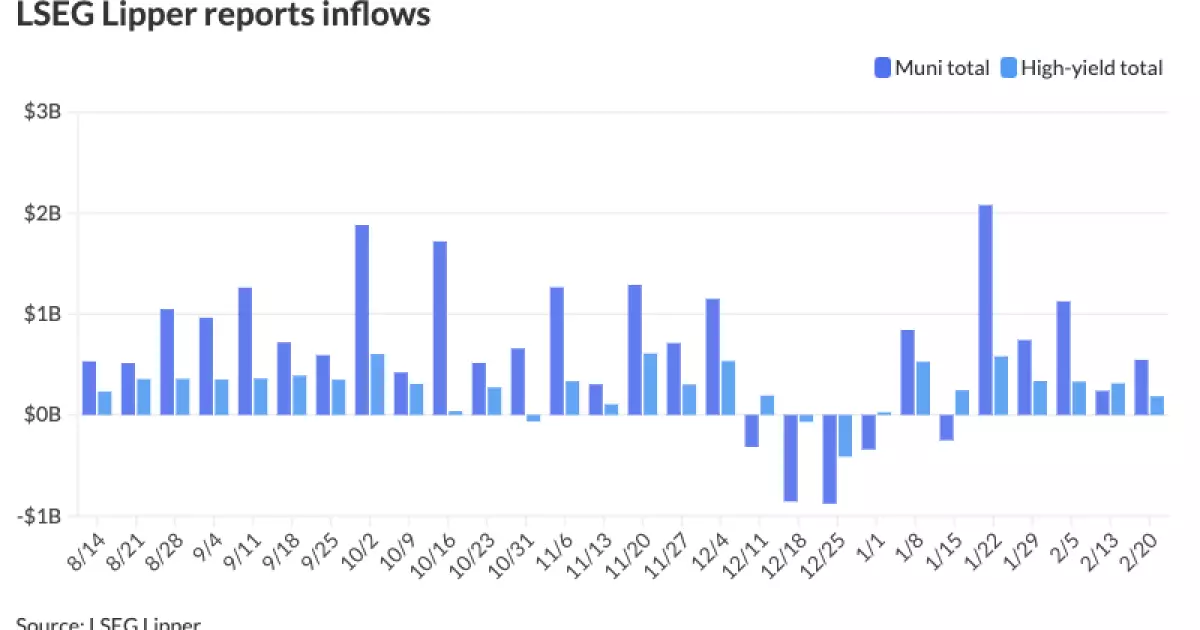The municipal bond market recently displayed a certain resilience, with developments highlighting key trends and shifts within an evolving financial landscape. As mid-February progresses, a noteworthy $2.5 billion project surrounding the Brightline West Passenger Rail underscores this dynamism, amidst fluctuations in treasury yields and the broader equity markets. Let’s delve deeper into the underlying factors shaping this sector and examine their implications for investors.
Recent trading sessions saw municipal bonds maintain a steady stance, creeping toward slight gains. Treasury yields experienced a slight decrease, contributing to a subdued yet stable environment for tax-exempt bonds. This was particularly apparent in the current yield ratios, where the two-year municipal to U.S. Treasury (UST) ratio stood at a solid 62%. These ratios indicated a cautious optimism amongst investors as they navigated the complexities of macroeconomic data and the resulting market responses.
Contributing to this steadiness is the overall quietness in new bond issues, with a recorded issuance of $4.3 billion. Experts, including J.P. Morgan strategists, note that the inflow of significant reinvestment capital, expected to reach around $18 billion, will further bolster the municipal market during February. The potential for lower interest rates has become a key narrative, fostering an environment conducive to tax-exempt investments.
January’s volatility, primarily driven by inflation concerns, briefly pressured the 10-year UST yield up to 4.80%. However, as observed by James Pruskowski, Chief Investment Officer at 16Rock Asset Management, the month ultimately ended neutral at 4.54%. This ability for the market to adjust and stabilize even amid upward pressures suggests a degree of resilience within investor sentiment.
Moving into February, the expectation of rate volatility persists. Much of this is attributed to ongoing shifts in both macroeconomic indicators and investor behavior. A noted resurgence of interest in lower interest rates aligns well with increases in fund inflows, which have been characterized as “broadly supportive.” Such trends can indicate a green light for potential investments in tax-exempt bonds, particularly with the forecast of attractive yields based on historical trajectories.
From an investment perspective, the primary issuance pipeline remains robust, yet it encompasses challenges in sourcing targeted exposure due to an evolving composition. With dealer balance sheets regarded as well-managed, the anticipated influx of reinvestment capital will come at a crucial time. However, strategists caution that as reinvestment flows diminish, an increase in supply may create an environment of technical challenges between March and May.
Moreover, the landscape appears favorable for long-dated high-grade municipal bonds, particularly as yields approach yearly highs. Investors may find relative value here, especially when considering the long-term projections suggesting lower rates by 2025. J.P. Morgan analysts assert that absolute yields currently align well within historical trading ranges, potentially attracting a spectrum of investors looking for stable returns.
On Thursday, key bond issuances emerged from several notable players in the municipal market. For instance, Morgan Stanley oversaw the pricing of $2 billion in non-rated Brightline West Passenger Rail Project green revenue bonds, marking significant activity in infrastructure funding.
In a related vein, Miami-Dade County introduced over $527 million in airport revenue bonds, illustrating the persistent appetite for financing public infrastructure projects. This angle underlines a crucial narrative in the current investment landscape—the drive for sustainable and green initiatives.
Similarly, bonds from the Wisconsin Health and Educational Facilities Authority reveal a diverse array of financing solutions for essential services. This not only reinforces the sustained demand for municipal bonds but emphasizes their utility in advancing community objectives.
Investor sentiment remains buoyed, highlighted by the addition of $546.3 million to municipal bond mutual funds over a week, following the preceding week’s inflows. However, pressure exists within the high-yield segment, which saw a slowdown in inflows, indicating potential caution among risk-prone investors amidst changing market conditions.
Notably, taxable money market funds faced outflows, which adds another layer to the analysis of liquidity in current assets. The fluctuation in yields, particularly the recent adjustments within the SIFMA Swap Index, signals potential areas to watch for movement among buyers and sellers in the market.
Understanding these dynamics, along with the current positioning of yields across various maturities, can provide investors with critical insights for making informed decisions in the municipal bond space.
Navigating the municipal bond market requires an astute awareness of macroeconomic trends, evolving investor sentiments, and strategic financing initiatives. As market participants continue to adjust expectations in light of changing conditions, the path ahead remains rife with both opportunities and considerations for prudent investment strategies.

